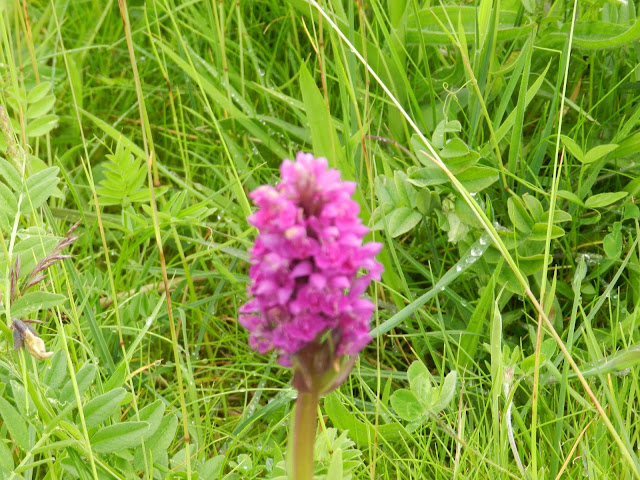Our wildlife watching started in Oban before we took the ferry
to Mull with sightings of the black guillemots that nest in the harbour. Walking along the coast we got better views
of them on the water, but unfortunately in the otherwise best photo there is no
beak, hence the back view!
Saturday
On route to Mull we saw terns, but at that distance it was not
clear whether they were common or arctic, probably common. Our rented cottage
was alongside a small loch that eventually led out to the sea. The sheltered harbour near the village was
home to a couple of noisy oystercatchers and their two chicks, fairly well
grown, but still being well protected by their parents. Noisy oystercatchers make good parents, but
we did wonder how many babies they had lost.
It is unlikely they started with just two. Something to look up perhaps. The small bay also had many herons. Most of the gulls here though were common
gulls rather than herring gulls. With
glorious sunshine we walked along the coast seeing goldfinches, greenfinches,
wheatears, larks, meadow pippits, sparrows, robins, mallards blackbids and of
course hooded crows. The photos for today have to be of the oyster catchers....(although the chick is not the best...)
Sunday was going to be the first wildlife tour, but David (our
wildlife expert and host) could not make it (after a long drive to
Craignure). With very rainy weather predicted
we took ourselves to Dunart castle (for the good food in the tearoom and yes it
was) which also turned out to be good for wildlife. Walking around on the shore and in the
grounds turned up a mink, (from what people have said – otherwise a black ferret!)
chaffinch, thrushes (which we were told were mistle thrushes) waders later
identifed as sandpipers, rock and meadow pippits, greater black backed gull,
wheatears and various orchids - and yellow flags and foxgloves, and a frog. The day is represented by a fragrant orchid, a butterfly orchid and an atlantic seal (I think, watching Jenny) and a sandpiper.
Monday took us on our trip with D W. We headed for Dunart castle again, but
stopped short of the castle to check out some trees where the white tailed
eagle was nesting, and managed to get a reasonable view of it flying. Unfortunately we did not manage to get
photographs of the sea eagles. We were
also told that the thrushes we saw on Monday at any rite were mistle thrushes
(Ann has since looked at a lot of sites in order to try to work on the
difference and it looks hard!) and then, we checked to see what was around at
grasspoint. Here we saw dolphins. Bottle nosed dolphins which are I think the
commonest around here. Quite a long way
out, but dolphins nevertheless. And just
the one seal – which is watching Jenny in the photo. Here also were more orchids including the amazing
fragrant orchid again – which really is very fragrant
Then we moved up towards the mountains where we spent quite a
lot of time watching a female hen harrier.
Although I saw hen harrier before in Mull (Ann), this time we were able
to watch one bird for quite a while – what an elegant bird, and how quickly she
moved. It was really important not to
lose sight of her against the landscape: take the binoculars away and you've
lost her. A little later we saw not just
one but two males, and although we saw male and female we did not see the food
pass.
In the mountains we saw a golden eagle flyig and a white tail at
the same time, helping to make the distinction, although they were far
away. We stopped at the golden eagles'
nest but did not get a view of it at the nest.
The following day, Tuesday, was more leisurely and we spent a
couple of hours walking around the peninsula, just on the small road. I think what we saw most here were wheatears,
and I’m wondering whether I have any photos!
But we also got quite good views of curlews in rather a bleak, boggy and
moorlike landscape. And as always, may
finches, pipits and larks. So here is a wheatear (although the photo is not from the trip, it was taken by Ann)
Wednesday was time for wildlife trip no. 2 – with Brian
(originally from Newcastle), and even before we picked up the second group from
their hotel, the three in the minibus saw a short eared owl (the photo is not
from this trip, but it IS a short eared owl and it was taken by Ann) and then
an otter, which we watched for a while (at a distance, till it gave us the
slip). After the others joined us it was
time for more otter searching, but we were not successful this time, and after
a while went up to the mountains to look
for eagles. After a while, one of the
golden eagles appeared and stooped down to stop on a ledge near the nest. A bit far to see well in the binoculars, but a
beautiful view in the scope, where the golden head and plumage was very
clear and hard to find in the first photos, so it is spot the eagle. (The other photos are from the scope, via
an iphone, hence the grainy quality and the round shape of the scope at the bottom).





































